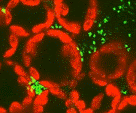Plant Pathology, Department of

Department of Plant Pathology: Faculty Publications
Document Type
Article
Date of this Version
1980
Abstract
The RNAs of brome mosaic (BMV), barley stripe mosaic (BSMV), and tobacco mosaic (TMV) viruses were inactivated by reaction with buffered glutaraldehyde. Glutaraldehyde did not fix 4% BMV-RNA, 20% t-RNA, 5% polyadenylic acid, or 5% adenosine monophosphate into water-insoluble precipitates, or gels, in distilled water or in low or high ionic strength buffers nor did it change their ultraviolet (UV) spectra. Two SDS- and phenolpurified commercial yeast RNA preparations from different sources gave UV spectra typical of pure RNA, but could not be freed of a contaminant that reacted with glutaraldehyde by forming a precipitate. The yeast RNAs did not become water-insoluble after glutaraldehyde reaction. BMV-RNA precipitated by Mg2+ could not be cross-linked into an insoluble form by glutaraldehyde. Nonfixation of RNA by glutaraldehyde must be considered in interpretation of attempts to localize RNA by electron microscopy.


Comments
Published in The Journal of Histochemistry and Cytochemistry Vol. 28, No.4,pp. 311-315, 1980. Copyright © 1980 by The Histochemical Society, Inc. Used by permission.